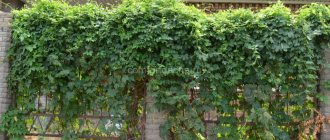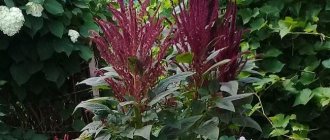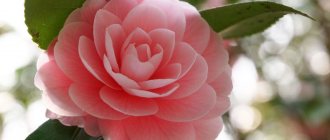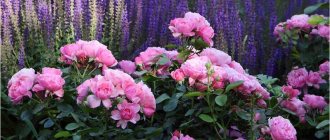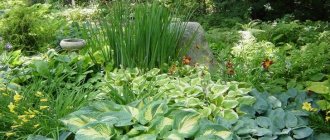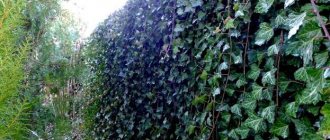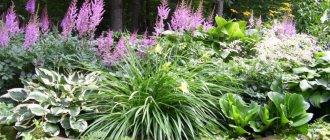Landscape Design Rules
The main area of the dacha is occupied by healthy fruit and berry plantings, vegetables and herbs. Naturally, there is very little space left for a flower garden.
As a rule, these are spaces along fences and near a country house. To fill this void, you need to know the principles of flower bed design.
Before deciding what to plant, you need to answer the following questions:
how much area is planned to be devoted to a flower garden. If the flower bed near the fence is long and large, then the choice of plants is practically unlimited. If there is very little space in the dacha, then the flowers should be miniature and not “aggressive”.
When planting, it is important to plant plants with the same requirements for watering, soil, and light. To do this, you need to find out which side the fence is on (sunny or shady), what crops the dacha owner plans to plant (whether they require care or not).
Flower garden along the fence Source pinterest.com
Near what kind of fence will there be a flower garden: solid or sparse (made of wooden slats, chain-link mesh, metal profile). What is the height of the fence, how hot does it get, whether it is necessary to hide the fence with plantings or leave it open.
When planting plants on the south side of the site, choose drought-resistant crops that need a lot of light. The soil in this part of the dacha will need to be constantly watered, so it is not recommended to plant delicate plants here that require abundant watering: crocuses, tulips. For a flower bed along the southern part of the fence, planting thyme, iris, and mallow is perfect.
On the northern side of the site, plants that can withstand strong winds and are cold-resistant are planted. For a flower bed near a fence, hosta plantings, stone compositions with coniferous shrubs, horizontal juniper, and ferns are well suited. In addition to low-growing plants, tall thujas can be planted on the side of the fence.
Most often, a flower bed is made with smooth borders and curves, as in this photo Source samozvetik.ru
Rigid rectangular flower beds can be arranged in the form of small compositions of flowers of different colors, but of the same type. For example, marigolds, petunias.
Flower arrangement Source pinterest.com.mx
What can be planted on the street side?
If you do not have a personal gardener, it is better to plant something decorative on the street side, but as easy as possible to care for.
Willows, birches, maples, chestnuts, lilacs, and pines grow almost independently. Unlike dwarf and short species, tall ones perfectly absorb dust, extraneous noise, and create a pleasant shadow.
Do you like to take care of your garden and don’t want too much darkness? Choose bushes (tea rose, juniper, rose hips, lilac) or flowers (peonies, dahlias, chrysanthemums, asters). Azalea and buddleia will grow well in the shade.
In the photo there are thujas outside the house
Planting along a mesh fence
To decorate a chain-link fence, many people use ordinary climbing plants: hops, virgin grapes, Jerusalem artichoke.
Flower garden Source news.rambler.ru
Some owners plant beans or peas.
In addition to them, a flower garden is planted, consisting of shade-tolerant plants and undemanding plants: lupine, rudbeckia (golden ball).
A flowerbed next to a mesh fence can consist of perennials Source sewerge.ru
Photos of plantings on the site and beyond
Newly planted fruit plants
Raspberry bushes after fencing
Living fencing of the site using conifers
Landscaping the borders of the garden area is a natural set of living colors of landscape design, which will make the area well-groomed, cozy and protected from prying eyes.
Planting along a wooden picket fence
A rare picket fence can be decorated on the wall side with tall flowers, for example, hydrangea, mallow or sunflower, and of course vines. These are girlish grapes, clematis, actinidia. And along the perimeter there are medium-sized or low-growing shade-loving crops.
In addition to flowers, it is popular among gardeners to plant small shrubs along wooden fences, such as honeysuckle, raspberries, currants, lilacs and others.
As for flowers, marigolds, petunia, and lobelia are used as low-growing flowers along the fence. First, a raised platform is used to organize the flower bed. Landscape design of a flower garden does not exclude hand-made. This can be any available materials: tires, tree logs, beautifully dug along the perimeter of the curb.
Small carts or even vintage bicycles that are used as flower beds Source urlaubitaliano.de
Conclusion
For transparent wrought-iron fences, picket fences or chain-link fences, coniferous or climbing plants are well suited. Loaches will beautifully entwine strips or rods. Conifers will block the view and make the fence more obscure.
If the area is large, plant tall trees; if it is small, we recommend limiting it to shrubs and flowers. If you choose trees, plant them at a distance of at least 3 m from the fence, otherwise they may “uproot” it.
Don't forget to care for your plants. Promptly remove those that have dried out or bloomed. If necessary, trim bushes and trees. For the winter, dig up perennial flowers and wrap ornamental bushes and trees with spunbond (this is not relevant for wild ones). To protect the roots from frost, sprinkle the soil near the plants with sawdust.
The categories mentioned in the article are:
Metal picket fence
Profiled sheet
Metal siding
Planting along a metal fence
The profile fence gets very hot in summer, so the plants are placed at a distance from it to avoid burns. For a flower garden along such a continuous fence, you can use plants of the same type. Hostas, decorative alliums, hydrangeas, etc.
Any beautiful tall flowers, as well as delphinium, pansies, and gladioli, are suitable for a lattice metal fence Source pinterest.com
Color combinations are used in such a way that flowering continues throughout the season. Thanks to this, flower beds along the fence will always look elegant and beautiful.
Flowers for large and wide flower beds along the fence are planted in tiered order. The closer to the fence, the higher the plant; the further away, the lower.
Stones, bricks, and bottles are used for decorative borders.
In the foreground are boxwood, low-growing thujas and junipers. Then, perennials are planted along the perimeter of the fence: primroses, heucheras, saxifrage.
If desired, the flower garden is supplemented with annuals: nasturtium, marigolds, snapdragons Source dachnyedela.ru
Option 4. Flower bed of filamentous yucca, geranium and Fassin's catnip
This option should be selected for sunny areas along the fence. Plant lavatera closer to the fence. It will delight with long flowering from July to October. A little further away, but in the same line or a little further from the fence, you can plant filamentous yucca. This plant is also called the “tree of happiness.” Dilute the composition with Perovka swan leaf. Fassin's catnip can be planted in the middle and foreground. If faded shoots are regularly pruned, the plant will bloom from May to September. Blood red geranium will help create a bright accent.
- Flowerbed in the sun: what flowers can grow in a dry and sunny area
Is your flower garden so open to the sun that in summer all living things literally burn out on it? Don't worry, you can deal with this by resorting to a few tricks.
Shrubs and trees along the fence
Very often, summer residents place trees and shrubs along the fence.
Trees and shrubs along the fence Source gardencreator.net
The most unpretentious of trees: mountain ash, hawthorn, fir, pine Source samstroy.com
When planting tall seedlings, their growth should be taken into account, so they are planted at a distance of 3-5 meters from the house, otherwise they can damage the foundation of the building.
More often, dogwood, elderberry, hydrangea, and dogwood bushes are located next to the fence. When planting the latter, take into account that it does not get along with barberry.
On the outside of the fence, it is customary to plant decorative species of shrubs that can create a hedge.
These can be rose hips, viburnum, bird cherry bushes Source wallpaperup.com
Goldenrod is aggressive! be careful
I really liked it in the picture, I really wanted to plant it.
Actually, I don’t like yellow in flowers, but here it’s just fluffy gold.
It is grown from seeds by sowing in the ground or through seedlings. In our store I found varieties Josephine and Golden Arrows. Used to create hedges, suitable for winter bouquets. Blooms from late July, August and September.
Goldenrod prefers sunny and partial shade, as well as moist soil.
Do not confuse the invasive wild species with Giant Goldenrod. We are talking about cultivated varietal goldenrod, bred by breeders.
Goldenrod was tamed and abandoned
Mixborders: photo ideas
Recently, landscape design along the fence has been organized using mixborders. These are plantings that are very diverse and bloom at different times. Thanks to these properties, mixborders look beautiful at any time of the year.
Flower arrangements can include not only low-growing plants, but also shrubs, fruit trees, climbing vines and other garden inhabitants.
When organizing this type of flower bed, the owner of the dacha must choose the plants correctly.
A landscape designer who knows the characteristics of each plant and its compatibility with its neighbors will help you cope with this. Source pinterest.com
Rabitz
An unpretentious dacha fence made of metal mesh with good coverage and metal posts can last for decades. By skillfully selecting the dominant plant, it can be made impenetrable at almost any time of the year.
Using mesh material as a fence allows you to plant climbing plants
Summer residents prefer to plant lilac, shadberry, chokeberry or barberry bushes along the mesh fence, from which flowering branches or fruits can be picked for medicinal purposes. However, this is not the best way out of the situation, because the shrub requires periodic renewal, and during the period when it does not bloom or bear fruit, it is a dull green mass.
If you form the bush correctly and leave it on the trunk in the form of a crown, a shady flower bed of perennials or unpretentious ornamental plants that climb and prefer to grow in the shade is an excellent way out of this situation. Craftsmen manage to build a kind of rock garden or rock garden from a narrow strip of land under bushes, combining the texture of natural stone and low plants.
The photo below shows the courtyard of a private house.
Rock garden goes well with the landscape
The second way to create a flowerbed under the chain-link with your own hands, if the shrub has not yet been planted, is climbing ornamental plants with a high degree of productivity of green mass. In such cases, it is recommended to plant bindweed, climbing roses, honeysuckle, virgin grapes and white dogwood.
Flower garden arrangement diagram
If a person intends to limit himself to a one-time event, the absolute way to create a flower garden under the chain-link is male dogwood. In addition to picturesque shady thickets, flowers with a pleasant aroma and berries, it has another undeniable advantage - it lives for about 200 years.
The photo below shows berries in the garden.
The red berries of the dogwood bush will fill the surrounding space with a rich fragrance
Types of flower beds
There are several types of mixborders depending on its design and content:
Classic flower garden along the fence (English type). Characterized by its strict lines, tree crowns are typically shaped and trimmed to form a crown. In the vicinity of such shrubs there are cereal crops (rye, oats, etc.), aster and other ornamental flowers.
Classic flower garden Source m.yukle.mobi
Meadow type of flower bed. It assumes a chaotic arrangement of meadow flowers, as they grow in nature: daisies, cornflowers, wild cereals and others.
Meadow type of flower bed Source pxhere.com
Village type. In the vicinity of lush flowering cereal crops and herbs, you can find decorative flowers and even berry bushes.
Rustic type of flower bed Source decoratorist.com
Mixborder scheme
Plant tall plants up to 1.5 meters in height closest to the fence. These are rudbeckia, asteraceae, foxgloves and other perennials with large flowers and leaves.
When selecting flower arrangements, designers usually arrange two or three crops of different flowering periods together so that the fence does not look bare.
Secondly, medium-sized plants are planted. This row creates the splendor of the entire composition, so plants are chosen for it that, even after flowering, do not lose their attractiveness.
These can be pinesettum, chrysanthemums, lavender Source sewerge.ru
Lastly, form the border of the flower bed. Ground cover plants are best suited for this. For example, spirea, nasturtium, cornflowers.
An example of a mixborder scheme Source krapivada.ru
Lupines have absorbed all the colors of the rainbow
I grew them. We liked them for their unpretentiousness and appearance. They grow into lush bushes. The foliage is beautiful, openwork.
Lupins by the fence
There are a lot of advantages. The seeds are large, sowed directly into the ground. Lupine, a member of the legume family, also enriches the earth with natural nitrogen. There is no color of the rainbow that is not found among lupins: red, yellow, blue, blue, orange, and also pink, white, lilac, violet.
There are also disadvantages:
- They grow quickly both by root and by self-sowing. Old bushes bloom worse; they need to be divided and replanted.
- There were cases that in the spring lupine did not grow back from the old root, or frail branches grew, and there were no flowers.
- They bloom for a short time - 3 weeks in May or June.
- After flowering they look ugly; instead of buds, beans with seeds appear and turn yellow. You need to cut off the flower stalks.
But I already miss lupins and want to plant them again?
The flower is not picky about soil, but grows better on moderately moist soil, without stagnant water. Loves sunny places.
Photo examples of beautiful solutions
The current option is to plant flowers and shrubs along the fence Source pinterest.com
There is no need to plant plants that will grow quickly Source wearefound.com
All plants must have similar watering needs Source gardenscout.com
Easy-to-care plants can decorate any area Source artsoznanie.com
Various plants that bloom at the same time create a magnificent riot of colors Source pinterest.com
It is better to choose unpretentious plants Source stroypay.ru
For this option you need to choose low-growing plants Source nightcore.club
It is better to choose plants that are easy to care for. Source pinterest.ca
Many plants can bloom until October (in warm weather) Source pinterest.com
Successful combination of colors Source landshaft-stroy.ru
Many plants can hide even a nondescript fence Source landshaft-stroy.ru
When choosing plants, you need to take into account the illumination of the area Source pinterest.com
All flowers should have similar soil needs Source pinterest.com
Some plants can grow too quickly Source pxhere.com
